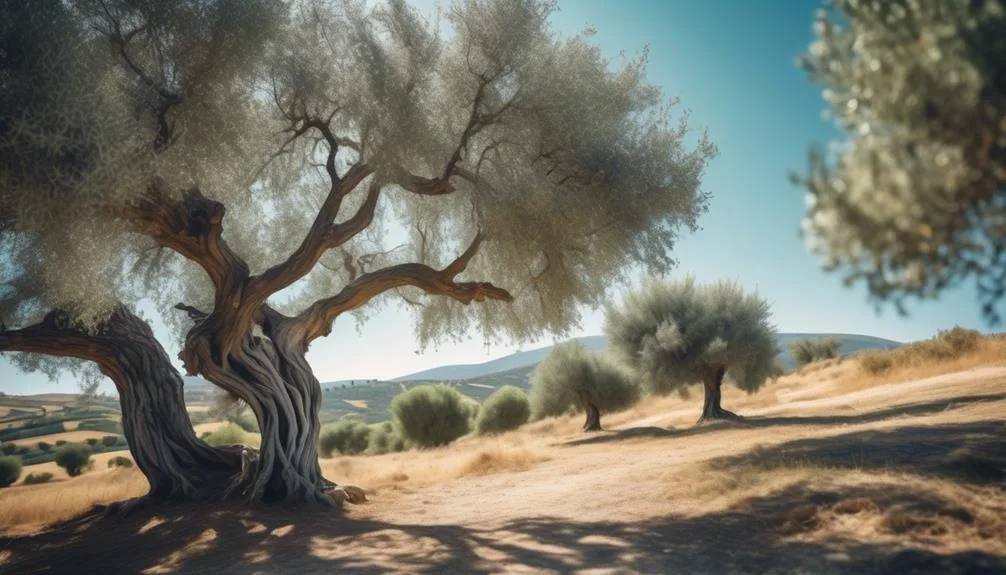The olive tree has its origins in the ancient Mediterranean Basin, where it has been cultivated since 6000 BC. Its journey spans across Ancient Greece, the Middle East, and North Africa.
If you've ever wondered about the beginnings of this beloved tree, its story is as ancient as it is fascinating, traveling across continents and civilizations.
Key Takeaways
- Olive tree cultivation has been intertwined with Mediterranean agriculture for thousands of years.
- The olive tree has significant cultural and symbolic importance in ancient Greece, the Middle East, Asia Minor, and North Africa.
- Olive oil is a staple in Mediterranean cuisine and has various uses beyond cooking, including religious ceremonies, lighting lamps, and skincare.
- Olive groves shape the landscape and provide livelihoods, contributing significantly to the economy and traditions of Mediterranean regions.
Mediterranean Basin
Exploring the Mediterranean Basin reveals the rich and diverse history of the olive tree and its deep cultural significance to the region.
Mediterranean agriculture has been deeply intertwined with the cultivation of olive trees for thousands of years. The olive tree holds a special place in the hearts of Mediterranean people, not only for its fruits but also for the oil extracted from them, which has been a staple of the region's cuisine, economy, and traditions.
Olive tree cultivation has shaped the landscape and culture of the Mediterranean, with its groves dotting the hillsides and providing livelihoods for generations. The resilience of the olive tree in the face of harsh conditions has made it a symbol of peace, prosperity, and longevity in the Mediterranean Basin.
Ancient Greece
The cultivation of olive trees in Ancient Greece played a pivotal role in shaping the culture, economy, and daily life of its people. Olive trees were revered and their cultivation was surrounded by rituals and traditions. Here are some fascinating facts about ancient Greece's olive cultivation techniques:
- Olive trees were considered sacred and were often associated with various Greek gods and goddesses.
- The Greeks developed advanced irrigation systems to ensure the optimal growth of olive trees.
- Olive oil wasn't only used for cooking but also for religious ceremonies, lighting lamps, and skincare.
- The ancient Greeks practiced grafting to improve the quality of olives and develop new varieties.
- The olive harvest was a time of celebration, with communal feasting and music, symbolizing prosperity and abundance.
Ancient Greece's innovative techniques and deep reverence for olive trees continue to influence Mediterranean culture to this day.
Middle East
In the heart of the Middle East, the ancient tradition of cultivating olive trees has been deeply intertwined with the region's history, culture, and culinary practices. Agriculture development in the Middle East has long been shaped by the cultivation of olive trees, which have provided a vital source of food, oil, and economic sustenance for centuries.
The climate impact in the Middle East has played a crucial role in the successful growth of olive trees, as they thrive in the region's hot, arid climate. The dry and sunny conditions have been favorable for olive tree cultivation, making the Middle East an ideal environment for their growth.
The region's rich agricultural history and the enduring significance of olive trees in Middle Eastern culture highlight the profound impact of this ancient tradition.
Asia Minor
Nestled in the region historically known as Asia Minor, the cultivation of olive trees has been a defining element of the landscape and culture for millennia. The ancient land of Asia Minor holds a rich history of olive cultivation, shaping the identity of the region in profound ways.
As you explore the significance of olive trees in Asia Minor, consider the following:
- The timeless connection between olive cultivation and the cultural heritage of the region.
- The resilient nature of olive trees, standing as enduring symbols of strength and perseverance.
- The aroma of freshly pressed olive oil, filling the air with an intoxicating fragrance.
- The deep-rooted traditions surrounding olive harvesting, passed down through generations.
- The picturesque olive groves that dot the landscape, offering a tranquil and mesmerizing sight.
The legacy of olive cultivation in Asia Minor continues to captivate and inspire, weaving a narrative of resilience, tradition, and natural beauty.
North Africa
Amidst the captivating legacy of olive cultivation in Asia Minor, the journey now leads to the sun-drenched lands of North Africa, where the ancient tradition of cultivating olive trees has also left an indelible mark on the landscape and culture.
North African agriculture has been deeply intertwined with olive tree cultivation for thousands of years, shaping the region's identity and economy. The Mediterranean climate of North Africa, characterized by hot, dry summers and mild, wet winters, provides an ideal environment for the growth of olive trees.
Countries such as Morocco, Tunisia, and Algeria have a rich history of olive cultivation, with sprawling groves that contribute significantly to the world's olive oil production. The ancient techniques and traditions of olive cultivation in North Africa continue to be honored and upheld, symbolizing the enduring significance of this practice in the region.
Conclusion
In summary, the Mediterranean Basin, including Ancient Greece, the Middle East, Asia Minor, and North Africa, is the cradle of olive tree cultivation.
This rich heritage has deeply influenced the global significance of olive oil and its integral role in diverse cuisines.
The enduring popularity of olive trees reflects their profound impact on human civilization.

